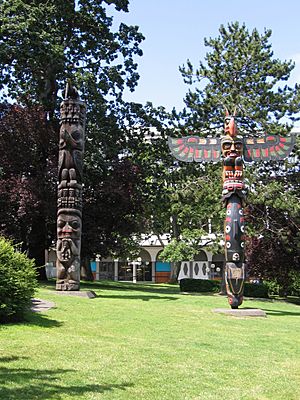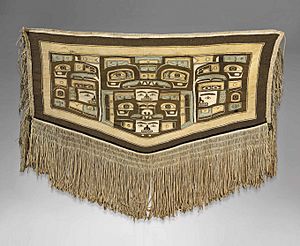Northwest Coast art facts for kids
Northwest Coast art is a special style of art. It was created by many different First Nations and Native American groups. These groups live along the Northwest Coast of North America. Some of these groups include the Tlingit, Haida, Heiltsuk, Nuxalk, Tsimshian, Kwakwaka'wakw, and Nuu-chah-nulth. This art style has been around for a very long time, even before Europeans arrived, and it is still made today.
Contents
What Makes Northwest Coast Art Special?

Northwest Coast art has a unique look. It uses special shapes called formlines, ovoids, U forms, and S forms. These shapes are often used to create animals and other figures.
Before Europeans came, artists mostly used wood, stone, and copper. A common wood was Western red cedar. Today, artists also use paper, canvas, glass, and precious metals.
The main colors used are red and black. Sometimes yellow is also used, especially by Kwakwaka'wakw artists.
Common Designs and Objects
The art often shows animals like bears, ravens, eagles, and orcas (killer whales). It also shows legendary creatures such as thunderbirds and sisiutls. Sometimes, the art uses abstract shapes that don't look like real things but are still made from the special Northwest Coast forms.
The most famous artworks are totem poles. These tall poles are carved with many figures. Artists also make special "bent-corner" or "bentwood" boxes, masks, and canoes.
Northwest Coast designs were also used on everyday items. These included spoons, ladles, baskets, hats, and paddles. Today, you can find this art style on paintings, prints, and sculptures in art galleries.
Textile Arts
People on the Northwest Coast also create beautiful textiles. These include Chilkat weavings, Raven's Tail Weavings, and Button Blankets. These are often used as special clothing for important events and ceremonies. They are made from materials like wool and yellow cedar bark.
History of Northwest Coast Art

Before Europeans arrived, the First Nations people of the Northwest Coast had rich cultures. They had complex social groups and ceremonies, like the potlatch. Art was a big part of their lives. Many artworks tell stories about their families and history.
In the late 1700s, Europeans came to the Northwest Coast. This brought many changes. Diseases like smallpox caused a huge drop in the population. People also faced pressure to change their ways and become more like European-North American culture. Because of this, less art was made for a while.
By the late 1800s, artists started making art to sell. Small carvings made from argillite (a type of stone) became popular. Many totem poles, masks, and other traditional artworks were also sent to museums and collectors around the world. Sometimes, the people who owned the art were paid, and sometimes they were not.
In the early 1900s, not many First Nations artists were making traditional art. But some artists, like Charles Gladstone and Mungo Martin, kept the old traditions alive.
Art Revival
In the mid-1900s, there was a new interest in Northwest Coast art. Artists like Bill Reid and art historians like Bill Holm helped bring it back. People also started to hold traditional ceremonies again, which needed new artworks.
Today, there are many schools that teach Northwest Coast art. There is also a growing market for new art in this style. Many communities are also asking for their traditional art objects to be returned from museums.
Respecting Cultural Art

Other nearby groups, like the Coast Salish peoples, also have their own art styles. While they share some things, their art is usually seen as different from Northwest Coast art. For example, Salish people made "welcome figures" but did not traditionally make totem poles or use the same formlines.
In traditional times, certain art patterns and designs could only be used by specific families or with their permission. Today, there are discussions about who has the right to create certain types of art. Some believe only First Nations artists from the right group should make certain designs. Others think that if an artist is respectful and has good intentions, it's okay. Some non-Native artists have even been adopted into First Nations families, which gives them the right to create such art. However, some people still believe that outsiders making art in a specific style can be seen as taking from the culture.
Famous Northwest Coast Artists
Many talented artists have created Northwest Coast art.
- 19th Century: Albert Edward Edenshaw (Haida), Captain Carpenter (Heiltsuk), Willie Seaweed (Kwakwak'wakw), Charles Edenshaw.
- 20th and 21st Centuries: Guujaaw, Charlie James, Henry Speck, Doug Cranmer, Stanley George, James Schoppert, Bill Reid, Mungo Martin, Ellen Neel, Robert Davidson, Beau Dick, Willie Seaweed, Roy Henry Vickers, Don Yeomans, Jay Simeon, Amos Wallace, Lyle Wilson, Sam (Sammy) Robinson, Ron Hamilton, Art Thompson, Joe David, Reginald Peterson, Freda Diesing, Lawrence Paul Yuxweluptun, Tony Hunt and Nathan Jackson (artist).
Important Art Experts
Some people have studied and written a lot about Northwest Coast art. They include Bill Holm, Bill Reid, Hilary Stewart, Bill McLennan, Martha Black, and George F. MacDonald. Books like Robes of Power by Doreen Jensen and Polly Sargent, and The Raven's Tail by Cheryl Samuel, teach us about traditional ceremonial robes.
Artist Emily Carr also used Native art as a theme in many of her early paintings, even though she didn't use the exact techniques.
See also
- Alaska Native art
- Button blanket
- Chilkat weaving
- Coast Salish art
- Formline art
- Haida argillite carvings
- Kwakwaka'wakw art
- Native American art
- Potlatch
- Totem pole
- Transformation mask



